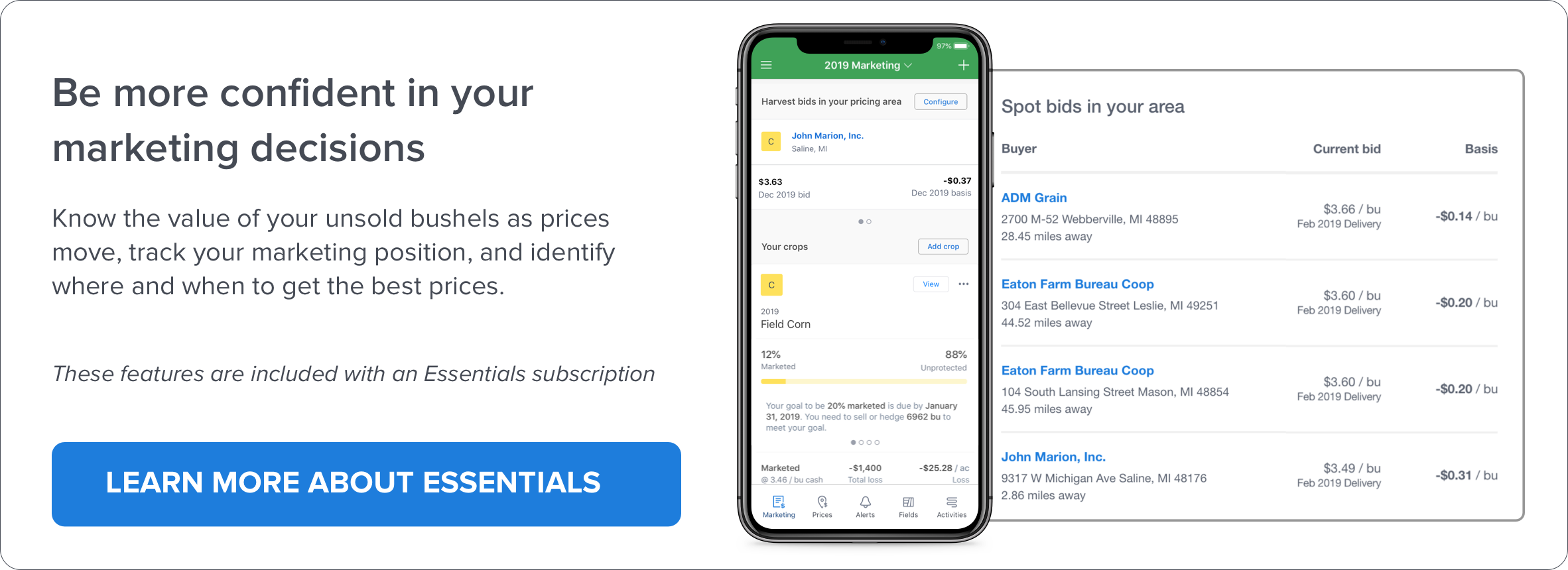Before using data to make my marketing decisions, I would call the elevator to see what the price of new crop corn or beans were, and if I'd sell some I’d write it on a piece of paper, hoping I’d remember where I'd put it. I never really took an exact approach to it where I would focus on things like my average yield and production costs. We’d thought we had figured out our cost of production, but we really hadn’t figured it down as close as we needed to.
So we’d have a haphazard market plan of selling some of our crops for whatever the price was at the time, and then we just kind of stopped working at it because we never really had our marketing plan looking us in the face.
That's just how we did it: we just sold a little, wrote it on a piece of paper, and that was it.
Sometimes I'd even forget how many beans I had sold so I'll have to call the elevator to find out.
Changing my approach to crop marketing
We started FarmLogs a couple of years ago and we liked it for keeping track of records, like where we planted certain backup varieties, when we sprayed, and that kind of stuff.
As the markets got worse and worse and FarmLogs announced the Marketing tool, we thought it could be a big help to our farm. So, we started entering in the stuff and figured out how to use the program pretty quickly. Then we start selling stuff and keeping track of it using Marketing, which helped us know that those sales were above our breakeven. Now, when we sell some of our crop we enter it in right away, and we always know what percent of our crop we’ve sold, what our price is on the average, where it's got to get delivered, and basis.
With FarmLogs, everything's right at our fingertips, and we know at a glance exactly where we're sitting.
The other great thing about the app is that even when I'm not thinking about marketing, it's looking at me like, "Hey, you've still got 50% of your crop you're dealing with. What are you going to do with that?”
Why you should know your true cost of production
Well, what I'm finding out as I look at it is that every decision, something like a change from Dicamba beans to Liberty, affects what you're going to make per acre. It sounds simple, and it is, but with FarmLogs it's so easy to put that information in one place.
Another thing I’ve realized is that when I was keeping track of this on paper I never quite allocated enough for my living expenses, but now I've got that number per acre in FarmLogs for my living expenses. So it's nice to know that everything is account for.
If it's explainable, it's good. Everything in FarmLogs that I do, it's explainable.
You can show it to your bank, you can show it to your crop people and you can say, "You know, when I'm doing this and what I'm spending", and I've got everything listed in there for all my expenses.
Even with the crop prices the way they've been, we've actually been able to sell a lot of corn above cost of production, and a lot of beans too. It's easy to do when you've figured out what your cost is, and it's a lot more comforting selling it knowing that I'm above waters instead of bleeding blood.
At the end of the day, we've got to be able to track what we're spending, what we're going to spend, and what we're planning. FarmLogs software is easy to use, it's easy to navigate around, and if you've got to make a change you know exactly what your actual costs are when they come in.
What does successful crop marketing look like?
We define success as profit. If you can make a profit—it might be 10 cents a bushel, it might be 30 cents a bushel—but if it's profit, that's success. It's really critical especially up in our part of the country.
You can be as good a farmer as you can be, but if you're not getting it sold right it doesn't matter.
You can grow 220 bushel/acre corn but if you didn't sell it right, you'll go broke. You have to know what it's costing you and what you're getting for it. It's pretty simple, and you guys have really simplified that in one program where you can put in your cost of production and your sales to see where you're at.
Visit our Crop Marketing Education page for more!
-2.png)

